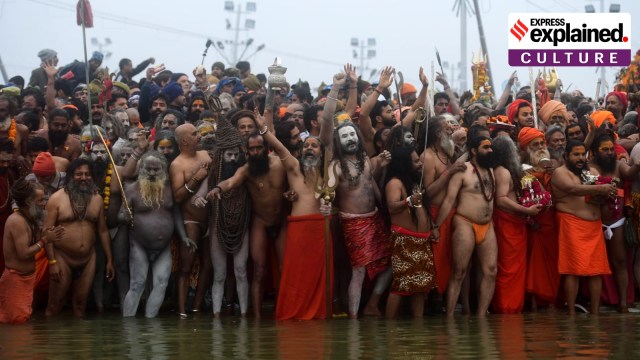Mahakumbh 2025 First Shahi Snan: January 14 was the first amrit snan or shahi snan at the Mahakumbh underway in Prayagraj. While the Kumbh Mela started on Monday, today was the first of the ritual baths, in which sadhu akhadaas take the first dip after an elaborate procession to the river.
Shri Panchayati Akhara Mahanirvani and Shri Shambhu Panchayati Atal Akhara were the first ones to take the amrit snan, PTI reported. Thirteen akhadaas are participating in the Maha Kumbh.

After the sadhus, or holy men, thousands of devotees took the dip in the sangam (confluence of Ganga, Yamuna and the mythical Saraswati) at Prayagraj.
Story continues below this ad
What is amrit snan or shahi snan, and why was the first one today? What is the significance of Makar Sankranti? What are the other auspicious dates for bathing at the Mahakumbh? We explain.
What is amrit snan?
The Kumbh Mela is held after every 12 years at Prayagraj, Haridwar, Nashik-Trimbakeshwar, and Ujjain, at the banks of the sangam, the Ganga, the Godavari, and the Kshipra rivers respectively. It is believed that bathing in these rivers during the Kumbh washes away one’s sins.
However, some dates during the Kumbh period are specially auspicious, depending on the alignment of planets, the Sun, and the Moon. The Kumbh Mela is attended by hundreds of sadhus, as part of their akhadaas or groups. Since this is a religious occasion, the sadhus are the “royalty” here, and thus they take the first dip. This ritual dip has traditionally been called the shahi snan or the royal bath. However, from this year, the bath is being called amrit snan. This is being seen as more in keeping with Hindu religious beliefs, as it is believed that Kumbh is celebrated at the four places where amrit, or the nectar of immortality, spilled after Samdura Manthan, or the churning of the ocean.
What is Makar Sankranti?
January 14 is Makar Sankranti, the day that the Sun moves into the Makar raashi or the zodiac Capricorn.
Story continues below this ad
Whenever the Sun moves from one raashi to another, it is called a Sankranti, but Makar Sankranti is special. This is because this marks the movement of the Sun from the south to the north, heralding that the worst of winter is over and warmer, sunnier days lie ahead.
 Mahakumbh: Women sadhus take a dip in Prayagraj on Makar Sankranti. (Express photo: Vishal Srivastav)
Mahakumbh: Women sadhus take a dip in Prayagraj on Makar Sankranti. (Express photo: Vishal Srivastav)
“With Makar Sankranti, the Sun is moving to uttar (north), and thus the Uttarayan period has begun. According to Hindu mythology, this period is the gods’ daytime. Thus, it is a reason to celebrate. After six months, the Sun will be in the Dakshinayan (southward) phase, which will be the gods’ night. Also, the Sun has now moved out of the Dhanu raashi (Sagittarius), marking the end of the kharmas, or the 30-day period in which auspicious activities are not undertaken,” said Dr Ramesh Kumar Upadhyay, president of the Bhartiya Jyotish Aadhyatm parishad in Jamshedpur.
Upadhyay explained that another reason Makar Sankranti is special is that the lord of the Makar raashi is Shani, Sun’s son. “A lot of Hindu beliefs and rituals centre the family and loved ones. Since Sun is moving into the house of his son, it is a reason to celebrate. One indication of how important Makar Sankranti is that in the Mahabharata, Bhishm Pitamah, who could choose the time of his death, chose the Uttarayan period,” Upadhyay said.
Makar Sankranti is also a harvest festival, similar to many celebrated in other parts of the country around this time. Taking a bath in a river on Makar Sankranti is believed to accrue spiritual merit, and if it coincides with the Kumbh, the benefits multiply manifold, it is believed.
Story continues below this ad
What are the other important bathing dates in the Kumbh this time?
After Makar Sankranti on January 14 is Mauni Amavasya on January 29 and Vasant Panchami on February 3. Shiv Ratri, which falls on February 26, the last day of the Kumbh Mela, is also significant.



 Mahakumbh: Women sadhus take a dip in Prayagraj on Makar Sankranti. (Express photo: Vishal Srivastav)
Mahakumbh: Women sadhus take a dip in Prayagraj on Makar Sankranti. (Express photo: Vishal Srivastav)




































